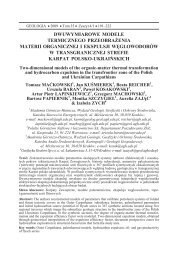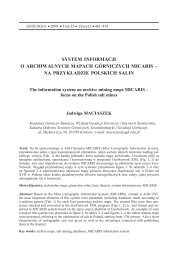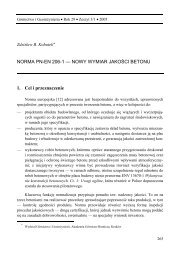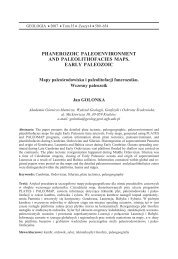MODELLING OF METAL OXIDE SURGE ARRESTERS AS ... - AGH
MODELLING OF METAL OXIDE SURGE ARRESTERS AS ... - AGH
MODELLING OF METAL OXIDE SURGE ARRESTERS AS ... - AGH
You also want an ePaper? Increase the reach of your titles
YUMPU automatically turns print PDFs into web optimized ePapers that Google loves.
ELEKTROTECHNIKA I ELEKTRONIKA<br />
TOM 27. ZESZYT 1, 2008<br />
1. INTRODUCTION<br />
Metal oxide surge arresters are fundamental elements of protecting<br />
systems of electric devices against overvoltages.<br />
They contain varistores, which main constituent is zinc oxide<br />
as well as small amounts of other metal oxides. Surge arresters<br />
are exposed to transient effect of overvoltages generated<br />
as a result of lightning discharges, switching and damage<br />
states in electric power systems.<br />
Modelling of surge arresters being in transient states, in<br />
case of large currents’ flow accompanying overvoltages has<br />
a practical importance. Analysing the risks of electric insulation<br />
systems of protected devices while overvoltages are exerting<br />
their influence, it is essential to know the voltages of<br />
arresters. The voltages determine efficiency of overvoltage<br />
protection of devices. Theoretically, voltage-current dependencies<br />
in established operation conditions make it possible<br />
to determinate energy dissipated in arresters, as well as<br />
taking into consideration influence of the arrester on currents<br />
in the circuit into which is it connected.<br />
Full and simplified version of a model of metal oxide<br />
surge arresters, selected from numerous types of models are<br />
presented in the paper. Parameters of the elements can be<br />
determinated on the basis of investigation carried out by producers<br />
as well as taking basic dimensions into consideration.<br />
Current-voltage dependencies of the surge arrester designed<br />
to 110 kV electric power systems were simulated. The results<br />
of calculations were compared to the experiment data.<br />
14<br />
Jakub FURGA£ * , Saad Khalifa Omar DAU **<br />
<strong>MODELLING</strong> <strong>OF</strong> <strong>METAL</strong> <strong>OXIDE</strong> <strong>SURGE</strong> <strong>ARRESTERS</strong> <strong>AS</strong> ELEMENTS<br />
<strong>OF</strong> OVERVOLTAGE PROTECTION SYSTEMS<br />
SUMMARY<br />
Metal oxide surge arresters are used for protection of high and low voltage electric devices against overvoltages. Mathematical<br />
models of surge arresters should properly represent current-voltage dependencies of varistors during influence<br />
overvoltages. From among numerous models created so far two versions of a selected model were used for computer simulations<br />
of current-voltage dependences of surge arresters. Parameters of elements of the selected model can be calculated<br />
by use of data published in the catalogues. Current-voltage dependencies of the surge arrester designed for electric power<br />
systems of 110 kV for different current stroke were modelled. The results of computer simulations were compared with the<br />
experimental data.<br />
Keywords: surge arresters, mathematical modelling<br />
MODELOWANIE OGRANICZNIKÓW PRZEPIÊÆ Z TLENKÓW <strong>METAL</strong>I JAKO ELEMENTÓW SYSTEMÓW<br />
OCHRONY PRZEPIÊCIOWEJ<br />
Ograniczniki przepiêæ s¹ powszechnie stosowane do ochrony przepiêciowej urz¹dzeñ elektrycznych wysokiego i niskiego<br />
napiêcia. Modele matematyczne ograniczników powinny w³aœciwie odzwierciedlaæ charakterystyki napiêciowo-pr¹dowe<br />
warystorów podczas oddzia³ywania przepiêæ. Spoœród wielu modeli opracowanych dotychczas do symulacji komputerowych<br />
zale¿noœci napiêciowo-pr¹dowych wybrano jeden model ograniczników. Parametry elementów modelu wyznaczono<br />
przy wykorzystaniu danych katalogowych. Modelowano zale¿noœci napiêciowo-pr¹dowe dla ró¿nych udarów pr¹dowych<br />
ogranicznika przepiêæ stosowanego w uk³adach elektroenergetycznych 110 kV. Obliczenia porównano z wynikami badañ.<br />
S³owa kluczowe: ograniczniki przepiêæ, symulacje komputerowe<br />
2. MECHANISM <strong>OF</strong> CURRENT CONDUCTIVITY<br />
IN <strong>METAL</strong> <strong>OXIDE</strong> VARISTORES<br />
Surge arresters contain one or more varistores with various<br />
diameters and heights. Varistores are made of ceramic of<br />
non-linear voltage-current characteristic. It is a ceramal of<br />
zinc oxide with admixtures of other metal oxides – i.e. of bismuth,<br />
cobalt, manganese and aluminium. Structure of the<br />
varistores’ mass is in the shape of close-packed grains. A<br />
small part of the grains constitute admixtures inside the<br />
grains while others, mainly bismuth, are accumulated in<br />
outer layers. Resistivity of the grain inside are small as opposed<br />
to resistively of outer layers. Non-linearity of the voltage-current<br />
characteristic results from phenomena occurring<br />
just mainly on the boundary of the grains. Between grains<br />
appear potential barriers, which regulate intensities of currents<br />
in dependence on voltage, as on the grain boundaries is<br />
considerable negative charge accumulated, being a result of<br />
existence of acceptor admixtures. With small voltage, voltage-current<br />
characteristic remains in accordance with the<br />
Ohm’s law, and depends on temperature. While increasing<br />
the voltage, energies of electrons can be high enough to pull<br />
electrons out of valence band. Electron-hole pairs of charges<br />
are created. Holes direct towards negatively charged boundary<br />
between grains, neutralising considerably surface charge<br />
and contributing to decrease of potential barrier. Sudden decrease<br />
of this barrier results in rapid current increase in the<br />
varistor. In this work range is the characteristic strongly<br />
non-linear. The non-linearity decreases, however, with po-<br />
* Department of Electrical Engineering and Electrical Power, <strong>AGH</strong> University of Science and Technology<br />
** Ph. D. Student at Department of Electrical Engineering and Electrical Power
tent lightning currents flow. With high density of currents,<br />
voltage increase is revealed, as a result of rise of voltage drop<br />
on grain-inside resistance. Character of phenomena on the<br />
grain boundary is the same as with lower current density.<br />
Dynamic properties of charges on inter-grain boundaries influence<br />
voltage-current dependencies. With very steep impulses,<br />
voltages on varistores increase faster than currents.<br />
Their maximal values are also higher for currents with<br />
shorter duration. These dependencies result from inertia of<br />
charge translocating in form of holes towards boundaries,<br />
decreasing barrier of potentials [1–3].<br />
3. CHARACTERISTIC <strong>OF</strong> SELECTED MODEL<br />
<strong>OF</strong> <strong>SURGE</strong> <strong>ARRESTERS</strong><br />
Research aiming to create a mathematical model of metal oxide<br />
surge arresters, which enables modelling of current-voltage<br />
relations in any work conditions, have been carried out<br />
for many years. Numerous models are the result of research<br />
carried out hitherto. They are presented, among others, in the<br />
references [4–13]. To calculations was used this model of<br />
which parameters can be calculated using the experimental<br />
values of residual voltages presented in manufacture catalouges<br />
and basic dimmensions of surge arresters. The model has<br />
been worked out by the IEEE Working Group 3.4.11 (The<br />
Institute of Electrical and Electronic Engineering) to calculate<br />
voltage-current dependencies in case of impulse currents<br />
flow with times of accretion of wave front from 0.5 sto45s<br />
(Fig. 1) [11, 12]. It contains two non-linear resistors A0(i)<br />
and A1(i) with various voltage-current characteristics, separated<br />
by a L1-R1 filter. A capacitor C represents capacitance<br />
of the arrester. To improve stability of calculations, a resistor<br />
R0 is connected parallel to the inductance L0. Parameters of<br />
linear elements and characteristics of non-linear resistors of<br />
the schema can be determinate from results of investigations<br />
of arresters, published in catalogues, as well as from elementary<br />
dimensions of the column of varistors.<br />
Fig. 1. Model of surge arresters worked out by IEEE<br />
Characteristics of varistors A0 and A1 of surge arresters with<br />
rated discharge current Ir are represented by formulas:<br />
A A U 8/ 20;<br />
0 w0<br />
1.6<br />
A A U 8/ 20;<br />
1 w1<br />
1.6<br />
l r<br />
l r<br />
(1)<br />
(2)<br />
ELEKTROTECHNIKA I ELEKTRONIKA TOM 27. ZESZYT 1, 2008<br />
where:<br />
U 8/ 20; lr – residual voltage with rated current impulse<br />
I r of times 8/20 s,<br />
Aw , A<br />
0 w – dependencies approximated by use of<br />
1<br />
formulas,<br />
w0 0<br />
0,051<br />
A0<br />
A c i<br />
w1 1<br />
0,0507<br />
A1<br />
A c i<br />
where:<br />
iA , i<br />
0 A – densities of currents in varistors A<br />
1<br />
0 and A1, c0, c1 – constants (c0 = 1.378, c1 = 1.083).<br />
Parameters of linear elements L0, R0, L1, R1 and C are expressed<br />
by dependencies:<br />
L<br />
R<br />
L<br />
R<br />
0<br />
1<br />
0<br />
1<br />
(3)<br />
(4)<br />
d<br />
0.2 [H] (5)<br />
n<br />
d<br />
1 00 [ <br />
n<br />
d<br />
1 5 [H] (7)<br />
n<br />
d<br />
65 [ (8)<br />
n<br />
n<br />
C 100<br />
d<br />
where:<br />
[pF] (9)<br />
d – height of the column of varistors, m,<br />
n – number of parallel varistor columns [11].<br />
As it appears from dependencies (1)–(9) the basis to calculating<br />
the parameters of elements of the model are results<br />
of studies of decreased voltage, presented in firm catalogues<br />
as well as main dimensions of the column of varistores. Correcting<br />
values of constsnts c0, c1 and inductance L1 can augment<br />
accuracy of calculations (Fig. 2).<br />
In calculations is this value taken, with which are the results<br />
of calculations converge with results of studies published in<br />
catalogues. The current-voltage equations for model of surge<br />
arresters presented in Figure 1 have the following form:<br />
du A () t<br />
0<br />
it ()– C – iA ( t)– iA ( t)<br />
0<br />
(10)<br />
0 1<br />
dt<br />
du() t du A () t<br />
0 di() t R0<br />
– – R0 – [ ut ( )– uA ( t)]<br />
0 (11)<br />
1<br />
dt dt dt L<br />
du A () t du A () t di A () t<br />
0 1 1<br />
– – R1 <br />
dt dt dt<br />
R1<br />
[ uA ( t)– uA ( t)]<br />
0<br />
0 1<br />
L<br />
1<br />
Systems (10)–(12) comprise non-linear equations.<br />
0<br />
(12)<br />
15
Jakub FURGA£, Saad Khalifa Omar DAU<br />
<strong>MODELLING</strong> <strong>OF</strong> <strong>METAL</strong> <strong>OXIDE</strong> <strong>SURGE</strong> <strong>ARRESTERS</strong> <strong>AS</strong> ELEMENTS <strong>OF</strong> OVERVOLTAGE PROTECTION SYSTEMS<br />
Fig. 2. The block scheme of the correcting process of the model<br />
parameters<br />
A simplified version of substitute scheme of metal oxide<br />
surge arresters recommended by the IEEE (Fig. 1) is shown<br />
in Figure 3. The structure of the proposed model with minor<br />
adjustments to give accuracy to the dynamic behavior of the<br />
metal oxide surge arresters. The two resistance in parallel with<br />
inductance are removed. Only one resistance between the input<br />
terminals is connected. The operating principle is quite<br />
similar to that of the full IEEE model placed in Figure 1 [13].<br />
The current-voltage characteristics of varistors A0 and A1<br />
are determined by using equations (1) and (2). To calculation<br />
of the inductances L0 and L1 the following equations can be<br />
used (values in H):<br />
16<br />
Fig. 3. Simplified IEEE substitute scheme of metal oxide surge<br />
arresters<br />
L<br />
1<br />
1 U – U<br />
2<br />
<br />
4 U<br />
r 1/ T r 8/ 20<br />
r 8/ 20<br />
U<br />
n<br />
(13)<br />
L<br />
0<br />
1 U – U<br />
2<br />
<br />
12 U<br />
r 1/ T r 8/ 20<br />
r 8/ 20<br />
U<br />
n<br />
(14)<br />
where:<br />
Un – rated voltage of surge arrester, V,<br />
Ur1/T , U<br />
2 r 8/20 – residual voltage for surge current<br />
10 kA with shapes: 1/T2 s and<br />
8/20 s respectively, V.<br />
The proposed criteria does not take into consideration any<br />
physical characteristic of the arrester. Only electrical data are<br />
needed. The inductance L0 in the model represents the inductance<br />
associated metal oxide surge arrester elements. And<br />
the inductance is very small, L0 was set a small value, during<br />
the impulse current tests, special care was taken to minimize<br />
lead inductance. The inductance L1 is the inductance associated<br />
with magnetic fields in the immediate vicinity of the arresters.<br />
The function of the inductive element is to characterize<br />
the model behavior with respect to lightning surges. The<br />
voltage across in the surge arrester reaches a peak before the<br />
current reaches its peak.<br />
The equations (13), (14) are based on the fact that parameters<br />
L0 and L1 are related to the roles that these elements<br />
have in the model. Since the function of the inductive elements<br />
is to characterize the model behavior with respect to<br />
fast surges. It seemed logical to define these elements by<br />
means of data related to arrester behaviour during fast voltage<br />
surges.<br />
The current-voltage equations for the substitute scheme<br />
presented in Figure 3 can be written as follows:<br />
d[ iA ( t)– iA ( t)]<br />
di A () t<br />
0 1 1<br />
ut ()– L0 – L1 – uA( t)<br />
0 (15)<br />
1<br />
dt<br />
dt<br />
ut ()– L<br />
0<br />
d[ iA ( t)– iA ( t)]<br />
0 1<br />
– uA( t)<br />
0<br />
(16)<br />
0<br />
dt<br />
ut ()– RiR() t 0 (17)<br />
i()– t i ()– t i ()– t i () t 0<br />
(18)<br />
R A0 A1<br />
Nonlinear equation systems (10)–(12) and (15)–(18) can<br />
be solved by use of the Newton’s method after differentiation<br />
of equations using trapezoidal method.<br />
4. RESULTS <strong>OF</strong> <strong>MODELLING</strong><br />
Using the models above, voltage-current dependencies of the<br />
surge arrester type PEXLIM P 96 were determinated. Those<br />
arresters are used for overvoltage protection of devices in<br />
electrical power systems of rated voltage 110 kV [14]. Residual<br />
voltages of the experimental surge arrester are presented<br />
in Table 1.<br />
Parameters of linear elementes of the full model of arrester<br />
calculated by use of the equations (5)–(9) are as follows:<br />
L0 = 0.2 mH, L1 = 15 mH, R0 = 100 W, R1 = 65, C = 100 pF.
The values of inductances of the simplified model presented<br />
in Figure 3 calculated by use of equations (13) and<br />
(14) are as follows: L0 = 0.5 mH, L1 = 1.3 mH. The voltagecurrent<br />
dependencies of the varistors A0 and A1 determinated<br />
by use of formulas (1)–(4) are presented in Figure 4.<br />
ELEKTROTECHNIKA I ELEKTRONIKA TOM 27. ZESZYT 1, 2008<br />
Type<br />
of the surge<br />
arrester<br />
Rated voltage<br />
Un,kV Continuing<br />
operating voltage<br />
Uc,kV Residual voltage with different waveforms for discharge current values, kV<br />
1/5 s 8/20 s 30/60 s<br />
10kA 5kA 10kA 20kA 1kA 2kA<br />
PEXLIM P 96 96 77 232 208 219 240 188 194<br />
Fig. 4. Current-voltage dependences of the varistors A0 and A1<br />
of full and simplified IEEE model of the experimental surge<br />
arrester: 1 – UA0 = f(iA0),2–UA1 = f(iA1)<br />
Table 1<br />
Residual voltages of surge arresters of type PEXLIM P 96 [15]<br />
a) b)<br />
c) d)<br />
Time course of voltages and voltage current dependencies<br />
during flow of current impulses in the surge arrester<br />
were determinated. Shapes of the current impulses are defined<br />
by times T1/T2 = 8/20 s, 4/10 s, where: T1 – time till<br />
maximum, T2 – time till half of the peak, and maximal value<br />
of impulse currents is equal to 5 kA, 10 kA and 20 kA. Time<br />
courses of the currents are represented by dependencies:<br />
it ()= 2.18 Im exp(–0.065t)sin(0.107t) for 8/20 s (19)<br />
it ()= 2.07 Im [exp(–0.14t) – exp(–0.58t)] for 8/20 s (20)<br />
where:<br />
Im – maximal value of current, A,<br />
t – time, s.<br />
The time-voltage and current-voltage dependences for<br />
experimental metal oxide surge arresters type PEXLIM P 96<br />
simulated by use of full IEEE model during the current<br />
strokes with different shapes are presented in Figure 5.<br />
Fig. 5. Voltage-time and voltage-current dependences for metal oxide surge arresters type PEXLIM P 96 simulated by use of full IEEE<br />
model for the current strokes with different shapes and maximal values: 5 kA, 10 kA and 20 kA: a, c) time-voltage characteristics;<br />
b, d) current-voltage dependencies; a, b) current stroke 8/20 s; c, d) current stroke 4/10 s<br />
17
Jakub FURGA£, Saad Khalifa Omar DAU<br />
<strong>MODELLING</strong> <strong>OF</strong> <strong>METAL</strong> <strong>OXIDE</strong> <strong>SURGE</strong> <strong>ARRESTERS</strong> <strong>AS</strong> ELEMENTS <strong>OF</strong> OVERVOLTAGE PROTECTION SYSTEMS<br />
Calculation results of this dependencies performed by use<br />
of the simplified IEEE model are presented in Figure 6. Presented<br />
the results of calculations have been obtained solving<br />
of the equation systems (10)–(12) and (15)–(18) by use of<br />
MATLAB software.<br />
From simulation results it is possible to see that voltage-time<br />
courses are dependented form shapes of current<br />
strokes. Maximal values of residual voltages on the surge<br />
arrestes is dependented not only from maximal values of the<br />
current strokes and also from time courses of currents.<br />
Calculation errors were determined in order to compare<br />
the results of simulations of current-voltage dependencies of<br />
surge arrester by use of selected mathematical model. They<br />
were calculated by dividing the diferrences of values of theoretical<br />
and experimental maximal values of residual voltages<br />
and experimental value of residual voltage of surge arrester.<br />
The errors related to simulations of current-voltage dependencies<br />
of the experimental surge arrester by use of the full<br />
and simplified model of surge arresters performances are<br />
shown in Figure 7. They were calculated using calculation<br />
results presented in Figures 5 and 6.<br />
It is possible to see from errors of calculations maximal<br />
values which is presented in Figure 7 that in all the cases<br />
model results that full IEEE model has much lower errors<br />
than simplified model. It is also to note, that due to proposed<br />
adjustment mechanism, the errors for lightning discharge<br />
currents may be only positive. The results obtained are good<br />
18<br />
a) b)<br />
c) d)<br />
Fig. 6. Voltage-time and voltage-current dependences for metal oxide surge arresters type PEXLIM P 96 simulated by use of simplified<br />
IEEE model for the current strokes with different shapes and maximal values: 5 kA, 10 kA and 20 kA: a, c) time-voltage characteristics;<br />
b, d) current-voltage dependencies; a, b) current stroke 8/20 s; c, d) current stroke 4/10 s<br />
and they have good match with catalogue guarantee protective<br />
characteristics. Some small difference appeared between<br />
the computing and catalogue results. As general it may express<br />
that the IEEE model of surge arresters can be recommended,<br />
one and then it is good to used for simulation<br />
lightning and switching overvoltages.<br />
Fig. 7. Errors of calculations of maximal values of residual voltages<br />
for the three experimantal surge arresters for current strokes<br />
of 8/20 s determinated by use of full and simplified IEEE model<br />
of surge arresters
5. CONCLUSIONS<br />
From among numerous models of surge arresters one was selected,<br />
whose parameters can be determinated only on the<br />
basis of their dimensions and results of investigations published<br />
in the catalogues. Two versions of this model were<br />
used for computer simulations of voltage-time and voltage-current<br />
dependencies of high voltage surge arresters<br />
where are used in electric power systems of 110 kV. Theoretical<br />
maximal values of residual voltages obtained for different<br />
current shapes and peak values were compared to the experimental<br />
data placed in the catalouge. The errors of calculations<br />
for the full model are smaller than for the simplified<br />
one, but generaly the maximal values of error are smaller<br />
than 6%. Presented results of calculations confirm that both<br />
the full IEEE model as well as the simplified one reflect<br />
property of dynamic characteristics of surge arresters.<br />
References<br />
[1] Mahan G.D., Levison L.M., Philipp H.R.: Theory of Conduction in<br />
ZnO Varistors. Jour. of Appl. Phys., 1979, 50 (4), pp. 2799–2812<br />
[2] Mukae K., Tsudi K., Shiga S.: Zinc Oxide-Praseodymium Oxide Elements<br />
for Surge Arresters. IEEE Trans. on Pow. Deliv., 1988, Vol. 3, No. 2,<br />
pp. 591–597<br />
[3] Greuter F., Perkins R., Rossinelli M., Schmuckie F.: The Metal-Oxide<br />
Resistor-at the Heart of Modern Surge Arresters. ABB Rewiev,1989,<br />
No.1, pp. 362–369<br />
[4] Kim I., Fanabashi T., Sasaki H., Hagiwara T., Kobayashi M.: Study of<br />
ZnO Arrester Model for Steep Front Wave. IEEE Trans. on Pow. Deliv.,<br />
1996, Vol. 11, No. 2, pp. 834–839<br />
[5] Bak-Jensen B., Bak-Jensen J., Mikkelsen S.D., Sorensen T.J.: General<br />
Equivalent Circuit Model of a ZnO Arrester. 8th Int.. Symp. on High<br />
Volt. Engin., Yokohama (Japan), Aug. 23–27, 1993, pp. 409–412<br />
[6] Sarto M.S.: A Nonlinear Distributed Parameter Model for the Transient<br />
Analysis of Surge Arresters in Power Lines. Int. Symp. on Electrom.<br />
Compat. EMC’94, 13–16 Sept., 1994, Rome (Italy), pp. 687–692<br />
[7] Schmidt W., Meppelink J., Richter B., Feser K., Kehl L., Qiu D.: Behaviour<br />
of MO-Surge Arrester Bloks to Fast Transients. IEEE Trans. on<br />
Pow. Deliv., 1989, Vol. 4, No. 1, pp. 292–300<br />
[8] Fernández F., Diaz R.: Metal-Oxide Surge Arrester Model for Transient<br />
Simulations. IPST 2001 – Rio de Janiero (Brasil), pp. 322–327<br />
[9] itnik B., Babuder M., Muhr M., itnik M., Vidmar M.: Numerical<br />
Modelling of Metal Oxide Varistors. Proc. of the XIV Int. Symp. on<br />
High Voltage Engineering. Tsinghua University, Beijing (China),<br />
25–29 August 2005, paper B-49<br />
[10] itnik M., itnik B., Scuka V.: A Comparative Study of Two Varistors<br />
Models. 25th Int. Conf. on Lightning Protection ICLP’2000, Rhodes<br />
(Greece), 18–22 Sept. 2000, paper 9.8<br />
ELEKTROTECHNIKA I ELEKTRONIKA TOM 27. ZESZYT 1, 2008<br />
[11] IEEE Working Group 3.4.11. Modelling of Metal Oxide Surge Arresters.<br />
IEEE Trans. on Pow. Deliv., 1992, Vol. 7, No. 1, pp. 302 – 309<br />
[12] Li H.J., Blrasekaran S., Choi S.S.: A Parameter Identification Technique<br />
for Metal-Oxide Surge Arrester Models. IEEE Trans. on Pow.<br />
Deliv., Vol. 17, No. 3, 2002, pp. 736–741<br />
[13] Pinceti P., Giannettoni M.: A Simplified Model for Zinc Oxide Surge<br />
Arresters. IEEE Trans. On Power Delivery, Vol. 14, No. 2, April 1999,<br />
pp. 393–398<br />
[14] EN-60099-5 Surge arresters. Selection and application recommendations.<br />
[15] Internet side: www.abb.com.pl<br />
Wp³ynê³o: 14.09.2008 r.<br />
Jakub FURGA£<br />
Jakub Furga³ was born in 1950.<br />
He graduated from the Faculty of<br />
Electrical Engineering, Automatics<br />
and Electronics of <strong>AGH</strong> University<br />
of Science and Technology in Cracow.<br />
He received M.Sc. and Ph.D.<br />
degrees in electrical science in 1980<br />
and 1988 respectively. He works in<br />
Department of Electrical Engineering<br />
and Electrical Power of <strong>AGH</strong>.<br />
His research interests include overvoltages in power systems<br />
and overvoltage protection as well as diagnostics problems<br />
of power transformers.<br />
e-mail: furgal@agh.edu.pl<br />
Saad Khalifa Omar DAU<br />
Saad Khalifa Omar Dau was born<br />
in Gabel Gharbi (Libia) in 1959. He<br />
finished high school in Tripoli (Libia).<br />
He was graduated MSc from<br />
Faculty of Electrical Engineering in<br />
Warsaw University of Technology in<br />
1992. Now continuous doctorate study<br />
in Faculty of Electrical Engineering,<br />
Automatics, Computer Science<br />
and Electronics of <strong>AGH</strong> University of Science and Technology<br />
in Cracow.








